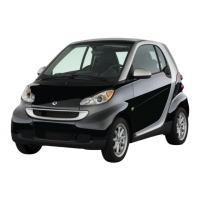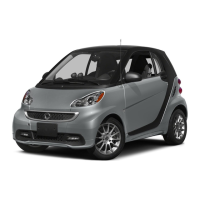G
WARNING
The distance warning function does not
react:
R
to people or animals
R
to oncoming vehicles
R
to crossing traffic
R
when cornering
Thus,
the
distance warning function cannot
provide a warning in all critical situa-
tions. There is a risk of an accident.
Always pay careful attention to the traffic
situation and be ready to brake.
G
WARNING
The distance warning function cannot
always clearly identify objects and com-
plex traffic situations.
In such cases, the distance warning func-
tion may:
R
give an unnecessary warning
R
not give a warning
There is a risk of an accident.
Always pay careful attention to the traffic
situation;
do
not rely on the distance warn-
ing function alone.
The · warning lamp in the instrument
cluster lights up if:
R
the distance maintained to the vehicle
travelling in front is insufficient
R
the vehicle is rapidly approaching a vehi-
cle travelling in front or a stationary
object. In this case, an intermittent warn-
ing tone also sounds
Detection can be restricted under the follow-
ing conditions:
R
the vehicle is new or service work has been
carried out on the system. In this case,
observe the information on running-in the
vehicle
R
the sensors are dirty or covered
R
in heavy rain or snow
R
interference by other radar sources, e.g. in
multi-storey car parks
R
the vehicle travelling in front is narrow,
e.g. a motorcycle
R
the vehicle travelling in front is travel-
ling on a different line
Following any damage to the front end of the
vehicle, have the configuration and opera-
tion of the radar sensor checked at a quali-
fied specialist workshop. This also applies
to collisions
at slow speeds where there is no
visible damage to the front of the vehicle.
X
Press the switch symbol.
If the forward collision warning is deac-
tivated, the indicator lamp lights up.
Adaptive brake lamps
The adaptive brake lights warn following
traffic in an emergency situation:
If you
brake the vehicle sharply from a speed
of more than 50 km/h the brake lamps flash
rapidly.
If the vehicle is sharply braked to a stand-
still at a speed of over 70 km/h, the hazard
warning lamps are also switched on automat-
ically. The hazard warning lamps switch off
automatically if you subsequently drive
faster than 10 km/h.
Driving with ESP
®
ESP
®
supports
the driver when pulling away on
wet or slippery roads. ESP
®
can also stabilise
the vehicle during braking. ESP
®
comprises
ETS (Electronic Traction System) and Cross-
wind Assist.
If ESP
®
detects that the vehicle is deviating
from the direction desired by the driver, one
46
Driving safely
>> Safety.

